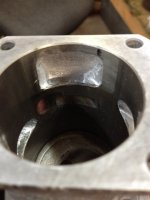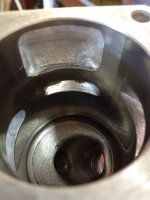What about piston Windows? The Charge starts out exiting through the piston windows in to the lowers. The piston windows are the first restriction the mix hits.
I'm totally just thinking out loud, but the mix is restricted at the piston Windows then kind of dumped into the lower transfers which are wider and more open than the piston Windows. Then it's redirected and compressed more before the upper transfers/fingers opens.
I built a 024 and opened the piston Windows. I was thinking at that time the benefit would be the windows were open to eliminate the first restriction.
I was thinking let the velocity increase come at the last point which is the upper transfers shape and size.
Think about it like a garden hose leave the end open the water doesn't go very far but put a small nozzle on the end and at It will spray far.
You would not put a nozzle internally mid hose and then expect the water to spray out of the end as if it was placed on the end.
Another benefit I thought about when I did this was being able to shed a lot of weight off of the piston.
I could be all wrong... But the saw runs great!! It seems to hang with the 026 I build.. I can't explain why??
I was going to read all the posts in this thread and then maybe comment. great! thread... rolls my sox up and down!!

but sharpshooter here (czar800) is echoing my thots in his post, and I cannot resist. btw - for the most part, I am reading these posts with cylinder and piston in it in hand...

great thread, no doubt!
* I'm totally just thinking out loud, but the mix is restricted at the piston Windows then kind of dumped into the lower transfers which are wider and more open than the piston Windows.
I do not think you can talk transfers effectively as a subject without including the piston in the conversation(s). I would not say the 'mix' is restricted at all. but I would say it will flow up and thru the piston windows (044) and that open area is significant. besides, on either sides of the piston at the pin boss are large openings. to me, these openings and windows do not designate a restriction other than possibly the piston not being there, but then... we don't have a saw!

as I see it, there is a lot of opportunity to blend these openings into the cyl and related areas, lots of flat sharp spots, mill ridge type stuff. I will give u an example. mocking up the squish set as to cyl to crankcase, the piston mocked up at BDC... I can clearly see, at least on my 044 cyl.. that where the piston window is at BDC, there is a mill ridge on the topside of the upper portion of the lower transfer port. both sides. I plan to blend these in to 'port match' the piston windows to this area of the transfer port. one only has to look inside cyl with piston at BDC to see numerous add'l port blending opportunities. I will tell u this, from my exp on my flow bench... all else remaining =, contouring and blending will pick up the cfm capacity of the column of air.
* I was thinking at that time the benefit would be the windows were open to eliminate the first restriction.
imo, it is not the first restriction. as I see it, the first restriction is in the area of crankcase to gasket to bottom flange/shape if cyl. but over all, the piston windows contribute to transfer filling, but a gas will take the path of least resistance, and the huge area on either side of the pin boss is wide open...

*
Think about it like a garden hose leave the end open the water doesn't go very far but put a small nozzle on the end and at It will spray far.
imo, good analogy. I see the upper transfers are smaller, perhaps for this reason. acceleration and to keep the gaoline in suspension as best as possible. but I see both upper transfer ports while they do have a directionally focused design on one side of the transfer port, both point towards the intake port area...
*Another benefit I thought about when I did this was being able to shed a lot of weight off of the piston.
not so sure this is a good idea. not on a working saw. case of the 044... with stuck rings in OE piston, the meteor piston w/o rings still weighs 12 grams more. with a focus on piston windows blending and opening... I would like to see my meteor piston about OE weight, and maybe 5-1o grams less just for fun of it. lends itself to a lot of cool contouring, porting and blend shaping of the windows, piston boss etc as the meteor is brought back into OE spec weights. maybe a bit more than 10 grams, but doubt more than 15. piston/rod is balanced by crankshaft counterweights, etc... more or less. imo, there is lot of room to work over the meteor piston to improve transfer port filling and cfm flow. but in any event, I do not think in terms of shedding ' a lot of weight', but some for sure.... how much weight removal is a lot to you and at same time acceptable? wondering. I have mulled over idea of removing lower piston skirt bosses. the upper is substantial. most of the force the piston is subjected to is thru compression and that is a vertical loading and resultant shape imo should support it. in considering piston windows I am reminded of how important the blowdown function is, effect and timing... and that all this 'basement' stuff is at about 5-6 psi. not a lot of pressure, but significant. it is hunting for path of least resistance, and there are many areas in 'basement' to further
help the dawg to hunt!
* I could be all wrong... But the saw runs great!!
no... and I, for one, do not think u r wrong at all. good to hear ur saw runs great! ok, back to reading this thread. prob read it several times. good stuff!









